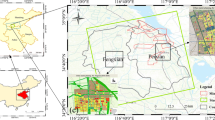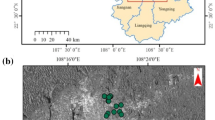Abstract
The North Peixian mining area of China has rich coal resources, with total proven reserves of 2.37 billion tons. However, the underground coal mining activities have resulted in ground collapse, which has caused serious harm to the environment and threatened the lives and properties of local residents. In this study, 12 Sentinel-1A terrain observation by progressive scans (TOPS) mode acquisitions between 30 July 2015 and 13 May 2016 over the abandoned mining area in North Peixian were analyzed using the interferometric synthetic aperture radar (InSAR) time series method to detect the ground subsidence, with the maximum ground subsidence reaching 83 mm/a and an average value of about 12.7 mm/a. The subsidence results derived from the Sentinel-1A TOPS mode dataset were proven to be effective in investigating and monitoring the ground subsidence in the North Peixian mining area. Compared to the rapid deformation during the ongoing period of mining excavation, the ground subsides slowly in abandoned mining areas and shows a linear relationship with time over a relatively long period of time. Spatial correlation between the subsidence distribution and land cover was found, in that the magnitude of the subsidence in urban areas was smaller than that in rural areas, which is associated with the controlled coal mining activities under buildings, railways, and water bodies. The results demonstrate that Sentinel-1A TOPS SAR images can be used to effectively and accurately detect and monitor ground subsidence in a mining area, which is critically important when investigating land subsidence in a large-scale mining area.





Similar content being viewed by others
References
Akcin, H., Kutoglu, H. S., Kemaldere, H., & Deguchi, T. (2010). Monitoring subsidence effects in the urban area of Zonguldak Hardcoal Basin of Turkey by InSAR–GIS integration. Natural Hazards and Earth System Sciences, 10(9), 1807–1814.
Bateson, L., Cigna, F., Boon, D., & Sowter, A. (2015). The application of the intermittent SBAS (ISBAS) InSAR method to the South Wales Coalfield, UK. International Journal of Applied Earth Observation and Geoinformation, 34(1), 249–257.
Chatterjee, R. S., Thapa, S., Singh, K. B., Varunakumar, G., & Raju, E. V. R. (2015). Detecting, mapping and monitoring of land subsidence in Jharia Coalfield, Jharkhand, India by spaceborne differential interferometric SAR, GPS and precision levelling techniques. Journal of Earth System Science, 124(6), 1–18.
Chaussard, E., Wdowinski, S., Cabral-Cano, E., & Amelung, F. (2014). Land subsidence in central Mexico detected by ALOS InSAR time-series. Remote Sensing of Environment, 140(1), 94–106.
Diao, X., Wu, K., Zhou, D., & Li, L. (2016). Integrating the probability integral method for subsidence prediction and differential synthetic aperture radar interferometry for monitoring mining subsidence in Fengfeng, China. Journal of Applied Remote Sensing, 10(1), 016028.
Dong, S., Samsonov, S., Yin, H., Ye, S., & Cao, Y. (2014). Time-series analysis of subsidence associated with rapid urbanization in Shanghai, China measured with SBAS InSAR method. Environmental Earth Sciences, 72(3), 677–691.
Gabriel, A. K., Goldstein, R. M., & Zebker, H. A. (1989). Mapping small evaluation changes over large areas: Differential radar interferometry. Journal of Geophysical Research, 94(B7), 9183–9191.
Geudtner, D., Torres, R., Snoeij, P., & Davidson, M. (2014). Sentinel-1 system capabilities and applications. In IGARSS 2014—2014 IEEE International Geoscience and Remote Sensing Symposium.
Goel, K., Adam, N., & Minet, C. (2011). Long term analysis of strong non-linear deformations induced by coal mining using the SBAS technique. Proceedings of Fringe 2011, Frascati, Italy. ESA SP-697, p. 17.
Grandin, R., Doin, M. P., Bollinger, L., Pinel-Puysségur, B., Ducret, G., Jolivet, R., & Sapkota, S. N. (2012). Long-term growth of the Himalaya inferred from interseismic InSAR measurement. Geology, 40(12), 1059–1062.
Grzovic, M., & Ghulam, A. (2015). Evaluation of land subsidence from underground coal mining using TimeSAR (SBAS and PSI) in Springfield, Illinois, USA. Natural Hazards, 79(3), 1739–1751.
Gupta, M., Mohanty, K. K., Kumar, D., & Banerjee, R. (2013). Monitoring surface elevation changes in Jharia coalfield, India using synthetic aperture radar interferometry. Environmental Earth Sciences, 71(6), 2875–2883.
Hennig, T. A., Kretsch, J. L., Pessagno, C. J., Salamonowicz, P. H., & Stein, W. L. (2000). The Shuttle Radar Topography Mission. Reviews of Geophysics, 45(2), 37–55.
Hooper, A. J. (2006). Persistent scatter radar interferometry for crustal deformation studies and modeling of volcanic deformation.
Hooper, A., Bekaert, D., Spaans, K., & Arıkan, M. (2012). Recent advances in SAR interferometry time series analysis for measuring crustal deformation. Tectonophysics, 514–517(1), 1–13.
Jin, B., Kim, S. W., Park, H. J., Jung, H. S., Kim, K. D., & Kim, J. W. (2008). Analysis of ground subsidence in coal mining area using SAR interferometry. Geosciences Journal, 12(3), 277–284.
Jung, J., Kim, D. J., & Park, S. E. (2014). Correction of atmospheric phase screen in time series InSAR using WRF model for monitoring volcanic activities. IEEE Transactions on Geoscience and Remote Sensing, 52(5), 2678–2689.
Liang, B., Yue, C., Chen, X. H., Wang, B., & Sun, X. K. (2014). The study of deformation monitoring based on the ground three-dimensional laser scanning technology. Advanced Materials Research, 1022, 387–391.
Liu, J., & Zhang, G. H. (2007). Numerical simulation research on moving and strain of over rock mined. Journal of North China Institute of Science and Technology, 4(2), 22–25.
Malinowska, A., & Hejmanowski, R. (2010). Building damage risk assessment on mining terrains in Poland with GIS application. International Journal of Rock Mechanics and Mining Sciences, 47(2), 238–245.
Miranda, N. (2014). Definition of the TOPS SLC deramping function for products generated by the S-1 IPF. European Space Agency, Paris, France, Technical Report.
Ng, A. H. M., Ge, L., Zhang, K., Chang, H. C., Li, X., Rizos, C. & Omura, M. (2011). Deformation mapping in three dimensions for underground mining using InSAR - Southern highland coalfield in New South Wales, Australia. International Journal of Remote Sensing, 32(22), 7227–7256.
Nishimura, T., Fujiwara, S., Murakami, M., Suito, H., Tobita, M., & Yarai, H. (2006). Fault model of the 2005 Fukuoka-ken Seiho-oki earthquake estimated from coseismic deformation observed by GPS and InSAR. Earth, Planets and Space, 58(1), 51–56.
Nolesini, T., Di Traglia, F., Ventisette, C. D., Moretti, S., & Casagli, N. (2013). Deformations and slope instability on Stromboli volcano: Integration of GBInSAR data and analog modeling. Geomorphology, 180–181(1), 242–254.
Przyłucka, M., Herrera, G., Graniczny, M., Colombo, D., & Béjarpizarro, M. (2015). Combination of conventional and advanced DInSAR to monitor very fast mining subsidence with TerraSAR-X data: Bytom City (Poland). Remote Sensing, 7(5), 5300–5328.
Saeidi, A., Deck, O., & Verdel, T. (2013). Comparison of building damage assessment methods for risk analysis in mining subsidence regions. Geotechnical and Geological Engineering, 31(4), 1073–1088.
Sun, Y. Z., Fan, J. S., Qin, P., & Niu, H. Y. (2009). Pollution extents of organic substances from a coal gangue dump of Jiulong Coal Mine, China. Environmental Geochemistry & Health, 31(1), 81–89.
Sun, Q., Zhang, L., Ding, X. L., Hu, J., Li, Z. W., & Zhu, J. J. (2015). Slope deformation prior to Zhouqu, China landslide from InSAR time series analysis. Remote Sensing of Environment, 156, 45–57.
Tizzani, P., Battaglia, M., Castaldo, R., Pepe, A., Zeni, G., & Lanari, R. (2015). Magma and fluid migration at Yellowstone Caldera in the last three decades inferred from InSAR, leveling and gravity measurements. Journal of Geophysical Research Solid Earth, 120, 2627–2647.
Torres, R., Snoeij, P., Geudtner, D., Bibby, D., Davidson, M., Attema, E., et al. (2012). GMES Sentinel-1 mission. Remote Sensing of Environment, 120(6), 9–24.
Xiao, W., Hu, Z., Gong, B., Zhang, P., & Han, B. (2011). Visualisation of the characteristics of mining subsidence with the consideration of topography: a case study in China. International Journal of Mining and Mineral Engineering, (1), 16–25.
Yagüe-Martínez, N., Prats-Iraola, P., González, F. R., & Brcic, R. (2016). Interferometric processing of Sentinel-1 TOPS data. IEEE Transactions on Geoscience and Remote Sensing, 54(4), 2220–2234.
Yan, S., Liu, G., Wang, Y., & Ruan, Z. (2015). Accurate determination of glacier surface velocity fields with a DEM-assisted pixel-tracking technique from SAR imagery. Remote Sensing, 7(8), 10898–10916.
Zhang, F. W., Hou, X. W., Han, Z. B., Yang, H. F., & Song, Y. X. (2003). Impact of coal mining subsidence on soil quality and some protecting technique for the soil quality. Geography and Geo-information Science, 19(3), 67–70.
Zhong, M. J. (2011). New regulations on mine geological environmental protection. Academic Forum, 191.
Zhou, J., Li, Z., He, X., Tian, B., Huang, L., Chen, Q., et al. (2014). Glacier thickness change mapping using InSAR methodology. IEEE Geoscience and Remote Sensing Letters, 11(1), 44–48.
Acknowledgements
We would like to thank ESA for providing the Sentinel-1 SAR dataset of the abandoned mining area in North Peixian. We thank NASA for providing the optical remote sensing image of LandSat8. We would also like to thank Andy Hooper, David Bekaert, Karsten Spaans for making the StaMPS Toolbox available. The research work is funded by Fundamental Research Funds for the Central Universities (No. 2015XKMS052), Natural Science Foundation of China (No. 51574221), Fundamental Research Funds for the Central Universities (No. KYLX16_0545).
Author information
Authors and Affiliations
Corresponding author
About this article
Cite this article
Liu, X., Wang, Y. & Yan, S. Interferometric SAR Time Series Analysis for Ground Subsidence of the Abandoned Mining Area in North Peixian Using Sentinel-1A TOPS Data. J Indian Soc Remote Sens 46, 451–461 (2018). https://doi.org/10.1007/s12524-017-0708-4
Received:
Accepted:
Published:
Issue Date:
DOI: https://doi.org/10.1007/s12524-017-0708-4




